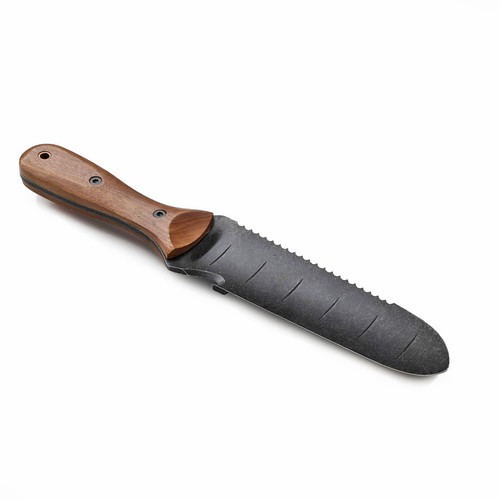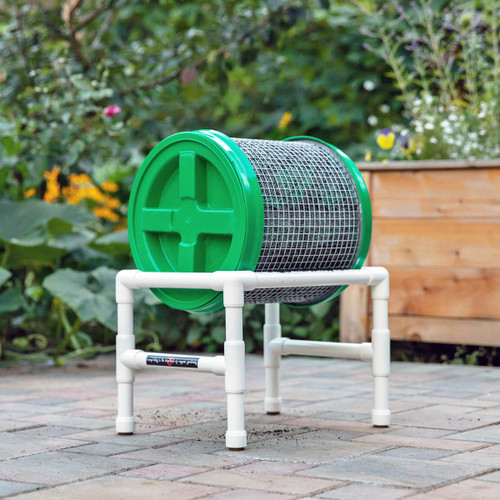
Free Shipping ( Ships within 3-5 Business Days: Processing time varies: Learn more )
The Hungry Bin allows you to convert your kitchen scraps and waste into nutrient-rich, organic fertilizer year round! It's continuous flow design means it needs minimal maintenance, and you won't have to handle stacking trays when harvesting your castings!
For Canadian customers, please contact us for pricing.
Overview
The Hungry Bin's innovative design is highly efficient and can process up to 4.5 lbs of waste per day while creating an ideal environment for your worms. Kitchen waste is quickly converted into castings and a nutrient-rich liquid, which are both high-quality natural fertilizers.
The Hungry Bin is a continuous flow vermicomposter that does not rely on turning, stirring or mixing like a conventional composter. The processed scraps are pushed down through the bin and the compressed castings are retained in the lower part of the bin, where they can be simply and easily removed when needed for use as plant food or soil conditioner.
The Hungry Bin system is modular, and if you produce more waste than it can process, simply add more bins as you need them! This makes Hungry Bins ideal for home composting as well as for schools and restaurants!
Composting worms can be purchased here!
Features & Benefits:
- Create compost year-round, indoors or outdoors
- Made from food safe & BPA-free polypropylene
- Process up to 4.5lbs of waste per day
- Wheels allow you to move the unit around
- Collect both the castings and "worm tea"
- Odorless operation
- Comes with 16-week feeding timeline to help increase the worm population
Please note the Hungry Bin does not include bedding material or worms. Composting worms can be purchased here, or from a variety of local and online sources.
The Hungry Bin is eligible for returns, though only if unopened.
Using Your Hungry Bin
Start with at least 80L of bedding so that the bin is 3/4 full. If you have bedding material available, you can fill it to the top of the taper before adding worms.
Moisten the bedding material with water until it is as wet as a wrung-out sponge. Add composting worms to the top of the bedding and cover them with about 1" of food scraps (preferably chopped). The amount of food you add will depend on your starting worm population.
Start with at least 1lb of composting worms, though the more you start with the faster the bin will reach a full population. Once full, there will be about 6.5lbs of worms. It takes 6-8 months to breed a full population from a small starting population of 1lb. Red Wrigglers are widely available online in different quantities!
Adding food scraps to the Hungry Bin is easy, just open the lid and toss the food in! Feed your worms about 50% food scraps and 50% fiber (e.g. paper or dry leaves). The amount you feed will depend on how many worms you started with. In general, worms can eat up to half their weight per day!
In normal operation, the castings can be removed every two to six months. The floor of the bin is easily removed, allowing ~ 4L (3/4 gallons) of castings to break away at the bottom of the taper to be harvested.
You can use the finished compost from your vermicomposter in your gardens and the liquid that drains down through the bin, passing through a filter, is also an ideal fertilizer. It is best to dilute the "worm tea" with a ratio of 1 part worm liquid to 10 parts water.
What to Feed your Worms:
Most fruit and vegetable scraps, pulps from juicer
Cooked food
Tea leaves/bags and coffee grounds
Crushed/ground eggshells
Hair, vacuum cleaner dust, soiled paper, tissue, paper towels, shredded egg cartons
Shredded newspaper, cardboard, sawdust (untreated), wood ash
Lawn clippings in small quantities, weeds, clippings, prunings, dirt and leaves
What to Avoid or Limit:
Limit citrus and acidic fruit skin
Limit bread, pasta and other wheat based products
Avoid hard fruit pits
Avoid spicy foods, onions, garlic and leeks
Avoid animal products such as meat, dairy, or fats
Avoid shiny paper
Do not feed rotten food to your worms
Taking Care of Your Worms
Worms are low maintenance and will be happy as long as they are fed, have enough moisture, and are kept between 40° and 80° F. Worms should be protected from extreme temperatures, direct sunlight, and direct rain. The Hungry Bin can be left outside depending on your temperature, or it can be brought indoors.
You don't need to feed your worms every day – just add scraps as you have them. Worms can survive up to 2 weeks without any new food. Worms reproduce inside the bin according to their space limitations. They will regulate their own population, so you never need to worry about overcrowding your bin.
It is very important that the Hungry Bin is not overfed. Worms prefer to eat their food as it begins to decompose, but not if it has become slimy and smelly. You should not add more than 1" of new scraps at once time, and uneaten food should not exceed 2" deep.
Description
The Hungry Bin allows you to convert your kitchen scraps and waste into nutrient-rich, organic fertilizer year round! It's continuous flow design means it needs minimal maintenance, and you won't have to handle stacking trays when harvesting your castings!
For Canadian customers, please contact us for pricing.
Overview
The Hungry Bin's innovative design is highly efficient and can process up to 4.5 lbs of waste per day while creating an ideal environment for your worms. Kitchen waste is quickly converted into castings and a nutrient-rich liquid, which are both high-quality natural fertilizers.
The Hungry Bin is a continuous flow vermicomposter that does not rely on turning, stirring or mixing like a conventional composter. The processed scraps are pushed down through the bin and the compressed castings are retained in the lower part of the bin, where they can be simply and easily removed when needed for use as plant food or soil conditioner.
The Hungry Bin system is modular, and if you produce more waste than it can process, simply add more bins as you need them! This makes Hungry Bins ideal for home composting as well as for schools and restaurants!
Composting worms can be purchased here!
Features & Benefits:
- Create compost year-round, indoors or outdoors
- Made from food safe & BPA-free polypropylene
- Process up to 4.5lbs of waste per day
- Wheels allow you to move the unit around
- Collect both the castings and "worm tea"
- Odorless operation
- Comes with 16-week feeding timeline to help increase the worm population
Please note the Hungry Bin does not include bedding material or worms. Composting worms can be purchased here, or from a variety of local and online sources.
The Hungry Bin is eligible for returns, though only if unopened.
Using Your Hungry Bin
Start with at least 80L of bedding so that the bin is 3/4 full. If you have bedding material available, you can fill it to the top of the taper before adding worms.
Moisten the bedding material with water until it is as wet as a wrung-out sponge. Add composting worms to the top of the bedding and cover them with about 1" of food scraps (preferably chopped). The amount of food you add will depend on your starting worm population.
Start with at least 1lb of composting worms, though the more you start with the faster the bin will reach a full population. Once full, there will be about 6.5lbs of worms. It takes 6-8 months to breed a full population from a small starting population of 1lb. Red Wrigglers are widely available online in different quantities!
Adding food scraps to the Hungry Bin is easy, just open the lid and toss the food in! Feed your worms about 50% food scraps and 50% fiber (e.g. paper or dry leaves). The amount you feed will depend on how many worms you started with. In general, worms can eat up to half their weight per day!
In normal operation, the castings can be removed every two to six months. The floor of the bin is easily removed, allowing ~ 4L (3/4 gallons) of castings to break away at the bottom of the taper to be harvested.
You can use the finished compost from your vermicomposter in your gardens and the liquid that drains down through the bin, passing through a filter, is also an ideal fertilizer. It is best to dilute the "worm tea" with a ratio of 1 part worm liquid to 10 parts water.
What to Feed your Worms:
Most fruit and vegetable scraps, pulps from juicer
Cooked food
Tea leaves/bags and coffee grounds
Crushed/ground eggshells
Hair, vacuum cleaner dust, soiled paper, tissue, paper towels, shredded egg cartons
Shredded newspaper, cardboard, sawdust (untreated), wood ash
Lawn clippings in small quantities, weeds, clippings, prunings, dirt and leaves
What to Avoid or Limit:
Limit citrus and acidic fruit skin
Limit bread, pasta and other wheat based products
Avoid hard fruit pits
Avoid spicy foods, onions, garlic and leeks
Avoid animal products such as meat, dairy, or fats
Avoid shiny paper
Do not feed rotten food to your worms
Taking Care of Your Worms
Worms are low maintenance and will be happy as long as they are fed, have enough moisture, and are kept between 40° and 80° F. Worms should be protected from extreme temperatures, direct sunlight, and direct rain. The Hungry Bin can be left outside depending on your temperature, or it can be brought indoors.
You don't need to feed your worms every day – just add scraps as you have them. Worms can survive up to 2 weeks without any new food. Worms reproduce inside the bin according to their space limitations. They will regulate their own population, so you never need to worry about overcrowding your bin.
It is very important that the Hungry Bin is not overfed. Worms prefer to eat their food as it begins to decompose, but not if it has become slimy and smelly. You should not add more than 1" of new scraps at once time, and uneaten food should not exceed 2" deep.
- Key Feature:
- The Hungry Bin is easy to use and maintain while it turns your food waste into fertilizer!
- Materials:
- Polypropylene
- Color:
- Green
- Style:
- Worm Composter
- Capacity:
- 13 Cubic Feet
- Shipping Weight:
- 29 lbs.
- Operating Weight:
- 275 lbs.
- Operating Dimensions:
- 24" W x 25" L x 35" H
- Origin:
- Made in New Zealand
- Warranty:
- 5-Year Manufacturer's Warranty
- Lead Time:
- Ships within 3-5 Business Days
- No-hassle, 30 day returns
- No sales tax
- Quick shipping
- Secure shopping (SSL, PCI, McAfee Secure)
- In business since 2000
- Member of Better Business Bureau, Green America, and US EPA Watersense
- Carbon-neutral, Family-owned business that promotes sustainability!
Product Videos
Specifications:
- Key Feature:
- The Hungry Bin is easy to use and maintain while it turns your food waste into fertilizer!
- Materials:
- Polypropylene
- Color:
- Green
- Style:
- Worm Composter
- Capacity:
- 13 Cubic Feet
- Shipping Weight:
- 29 lbs.
- Operating Weight:
- 275 lbs.
- Operating Dimensions:
- 24" W x 25" L x 35" H
- Origin:
- Made in New Zealand
- Warranty:
- 5-Year Manufacturer's Warranty
- Lead Time:
- Ships within 3-5 Business Days























